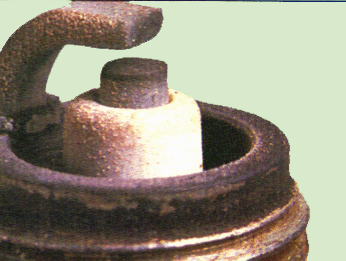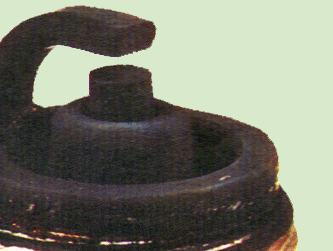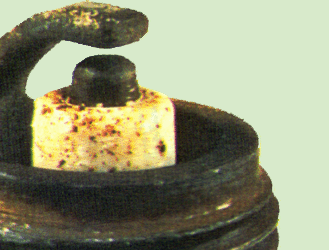Spark Plugs
The spark plug is a very important component in your engine. The spark plug ignites the fuel mixture inside the
cylinder by passing a huge voltage, approximately 40,000-100,000V (40kV-100kV), over an air gap. This air gap exists between the electrode (anode) and the ground (a piece of metal directly below the anode). An 'air gap' is like an open switch. The only time any current may cross the gap is when the potential on the anode gets high enough to jump to the ground. When this occurs, a visible spark can be seen as the resistance of the air is broken down and a split-second short circuit occurs. If this spark cannot occur, your gas will not be able to ignite and your engine will falter. The spark plug's job is not only to ignite the gas, but also to serve as a meter for your engine's overall health. Too black, you may be running rich, which will affect the ability for your engine to fully burn gas; too white, there is a chance that your engine is overheating. The plug should be a nice "chocolate brown" colour, and there should be a sharp, blue-white spark centered in the air gap. What follows is a guide to selecting, cleaning and monitoring spark plugs.
Plug Wear Patterns

|
|
This is what a good plug looks like. The anode should be square and the ceramic surrounding it should be light to chocolate brown. If your plug looks like this, your engine is probably pretty healthy and the timing is probably spot on.
|

|
|
This is an example of a fouled plug. Usually this condition is caused by a bad ignition system (misfiring), Too much fuel (a rich condition), or a plug that is too cold. Eventually this condition will prohibit the sparkplug conducting spark and the engine will get dirty from left over deposits. If you are having troubles with black, foul plugs, you probably need less fuel and more air being introduced into the engine. You may need to reduce the size of the main jet to allow less gas into the carburettor's air stream. Typically you would only change to a leaner jet for altitude changes. For a stock motor, you shouldn't have to mess with plug temperature values. a B8ES plug will take the most abuse of any of them. |

|
|
Here is a plug that has severely overheated. Blistering of the ceramic insulator and the rounding of the conductor surface indicates severe wear and high temperature melting. This is a very bad condition. If your plug looks like this, there is a good chance your engine is going to melt down. Adjust your carb to let more fuel mixture into the chamber, run a colder plug and check any performance components are matched to your engine configuration. Often performance exhausts and cylinder kits will vestly change the gas requirements of your engine. You will have to re-jet your carburettor to allow more gas and oil into the engine. |
Resistor Plugs versus Normal Plugs
There has been a great debate over the use of resistor plugs in Vespa scoots. Generally, they are not a good idea since the NGK spark plug cap fitted in most p200s is already resistive, and the ignition on Vespas is pretty underpowered when compared to modern motorcycles. Let's have a look at the theory behind a resistor spark plug.
The reason to use a resistor spark plug is mainly to reduce radio interference into the environment and to protect the High Voltage electronics from the damaging side effects of reflections of a high frequency, high-power situation. The most common place we observe the effects of line reflections is in every day cable TV splitters. If we have a television set connected to one side, and an unused split connection on the other (open-circuit), under worst case circumstances, the television set will display a garbled picture. The reason for this is analagous to throwing rock in a perfectly still pond. When the rock hits the water, waves ripple in a spherical pattern; throw another rock in the pond and you will get overlapping waves. In an electronics sense, you have ruined the information being sent and risk sending a more powerful wave back to the transmitter and other receivers in the chain. This phenomenon is called an impedance mismatch. If a resistance, 220 ohms in the case of televisions, is inserted in parallel to all the other circuits, it will channel all the unused energy at a split into useful work instead of wasting power in the environment. Thus, the resistor will prevent the picture from degrading.
In our previous example, we were shown the effect of reflections on a television, now we look at the spark plug. Using a normal spark plug without a parallel resistance, we render all personal communications equipment useless. The reflections from the spark plug produce unwanted harmonics that interfere with any radio equipment you may have. Okay so what do we do? The magic number is 5000 ohms (or 5k) as 5k ohms is roughly matched to the characteristic impedance of the ignition transformer. If we put a 5kohms resistor inside the spark plug or the plug cap, the resistance will balance the transmission circuit and provide maximum energy to the spark plug's anode. Since there will be much less unused energy, the circuit will release much less electromagnetic and radio radiation. The end result is that we get a more efficient spark and less radio interference. The problem with the integration of a resistor is that it is designed for newer ignition transformers. The P200's ignition system's characteristic impedance may not be as high as 5kohms so the resistor may not balance the circuit like it should, which makes the system less efficient. Some find that their bike will just die once enough carbon collects on the center electrode. NGK even warns people on their site about the complications associated with older ignition systems, but so far I haven't experienced any igniton problems due to failure of a resistive plug.
Selecting a Spark Plug
Whew, an easy topic. Buy a B8ES. Done. No? Wait. So you're in a pinch and you need a spark plug. There's a B8HS and a B8ES R and a B8EGV and etc. Maybe one of these will do? Careful now, lets not do anything rash. What's the difference here? Okay, I see a problem developing here and it comes up again and again. Here's a table for what to buy. This table is for stock bikes.
B9HS, B8HS, B7HS, B6HS - These are short ended spark plugs and will not work with a P200, so ignore them.
B9EGV, B8EGV, B7EGV, B9EGV - These plugs have a tiny center conductor in them and may not always be made of copper. I have had no experience with these plugs, but from NGK's site, they appear to be for high end motorcyles, not Vespas.
B9ES - This plug may cause erratic running at city speeds, and will foul easily because it runs so cold. if you are running 'lean' because of your carb, this plug may be a temporary fix.
B8ES - Utopia. this plug is perfect for slow city riding and runs fairly cold for highway rides.
B7ES - A bit hotter than the B8ES. This plug is reccomended for quick city rides because it will not foul easily. If you're going on the highway go a little colder.
B6ES - This plug runs 'hot' this plug should only be used for special circumstances where the engine may not be getting to full temperature or the carhb is running rich (too much oil/gas mix).
'R' - R means resistor plug, there is a 5K resitor in parallel with the spark plug electrically to provide less EMI (Electromagnetic Interference) and RFI (Radio Frequency Interference). See my lengthy discussion of the pro's and cons of this plug above. These plugs aren't a bad idea because they generally make the system work better.


All Material Copyright 2001-2025 by Richard Hoar. Use at your own risk.
|